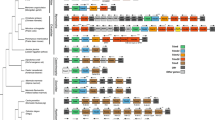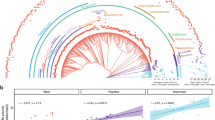Abstract
Retroviruses are the only group of viruses known to have left a fossil record, in the form of endogenous proviruses, and approximately 8% of the human genome is made up of these elements1,2. Although many other viruses, including non-retroviral RNA viruses, are known to generate DNA forms of their own genomes during replication3,4,5, none has been found as DNA in the germline of animals. Bornaviruses, a genus of non-segmented, negative-sense RNA virus, are unique among RNA viruses in that they establish persistent infection in the cell nucleus6,7,8. Here we show that elements homologous to the nucleoprotein (N) gene of bornavirus exist in the genomes of several mammalian species, including humans, non-human primates, rodents and elephants. These sequences have been designated endogenous Borna-like N (EBLN) elements. Some of the primate EBLNs contain an intact open reading frame (ORF) and are expressed as mRNA. Phylogenetic analyses showed that EBLNs seem to have been generated by different insertional events in each specific animal family. Furthermore, the EBLN of a ground squirrel was formed by a recent integration event, whereas those in primates must have been formed more than 40 million years ago. We also show that the N mRNA of a current mammalian bornavirus, Borna disease virus (BDV), can form EBLN-like elements in the genomes of persistently infected cultured cells. Our results provide the first evidence for endogenization of non-retroviral virus-derived elements in mammalian genomes and give novel insights not only into generation of endogenous elements, but also into a role of bornavirus as a source of genetic novelty in its host.
This is a preview of subscription content, access via your institution
Access options
Subscribe to this journal
Receive 51 print issues and online access
$199.00 per year
only $3.90 per issue
Buy this article
- Purchase on Springer Link
- Instant access to full article PDF
Prices may be subject to local taxes which are calculated during checkout




Similar content being viewed by others
Accession codes
Data deposits
The TLS EBLN and RBV sequences reported here have been deposited in the DDBJ/EMBL/GenBank and the accession numbers are shown in Figure 2.
References
Jern, P. & Coffin, J. M. Effects of retroviruses on host genome function. Annu. Rev. Genet. 42, 709–732 (2008)
International Human Genome Sequencing Consortium. Initial sequencing and analysis of the human genome. Nature 409, 860–921 (2001)
Zhdanov, V. M. Integration of viral genomes. Nature 256, 471–473 (1975)
Klenerman, P., Hengartner, H. & Zinkernagel, R. M. A non-retroviral RNA virus persists in DNA form. Nature 390, 298–301 (1997)
Geuking, M. B. et al. Recombination of retrotransposon and exogenous RNA virus results in nonretroviral cDNA integration. Science 323, 393–396 (2009)
Tomonaga, K., Kobayashi, T. & Ikuta, K. Molecular and cellular biology of Borna disease virus infection. Microbes Infect. 4, 491–500 (2002)
de la Torre, J. C. Molecular biology of Borna disease virus and persistence. Front. Biosci. 7, d569–d579 (2002)
Lipkin, W. I. & Briese, T. in Fields Virology 5th edn (eds Knipe, D. M. & Howley, P. M.) 1829–1851 (Lippincott Williams & Wilkins, 2007)
Chase, G. et al. Borna disease virus matrix protein is an integral component of the viral ribonucleoprotein complex that does not interfere with polymerase activity. J. Virol. 81, 743–749 (2007)
Ewing, R. M. et al. Large-scale mapping of human protein–protein interactions by mass spectrometry. Mol. Syst. Biol. 3, 89 (2007)
Mercer, J. M. & Roth, V. L. The effects of Cenozoic global change on squirrel phylogeny. Science 299, 1568–1572 (2003)
Kistler, A. L. et al. Recovery of divergent avian bornaviruses from cases of proventricular dilatation disease: identification of a candidate etiologic agent. Virol. J. 5, 88 (2008)
Francischetti, I. M., My-Pham, V., Harrison, J., Garfield, M. K. & Ribeiro, J. M. Bitis gabonica (Gaboon viper) snake venom gland: toward a catalog for the full-length transcripts (cDNA) and proteins. Gene 337, 55–69 (2004)
Hui, E. K., Wang, P. C. & Lo, S. J. Strategies for cloning unknown cellular flanking DNA sequences from foreign integrants. Cell. Mol. Life Sci. 54, 1403–1411 (1998)
Holmes, E. C. Molecular clocks and the puzzle of RNA virus origins. J. Virol. 77, 3893–3897 (2003)
Duffy, S., Shackelton, L. A. & Holmes, E. C. Rates of evolutionary change in viruses: patterns and determinants. Nature Rev. Genet. 9, 267–276 (2008)
Korber, B., Theiler, J. & Wolinsky, S. Limitations of a molecular clock applied to considerations of the origin of HIV-1. Science 280, 1868–1871 (1998)
Morrish, T. A. et al. DNA repair mediated by endonuclease-independent LINE-1 retrotransposition. Nature Genet. 31, 159–165 (2002)
Maestre, J., Tchenio, T., Dhellin, O. & Heidmann, T. mRNA retroposition in human cells: processed pseudogene formation. EMBO J. 14, 6333–6338 (1995)
Esnault, C., Maestre, J. & Heidmann, T. Human LINE retrotransposons generate processed pseudogenes. Nature Genet. 24, 363–367 (2000)
Kazazian, H. H. Mobile elements: drivers of genome evolution. Science 303, 1626–1632 (2004)
Zhang, Z., Carriero, N. & Gerstein, M. Comparative analysis of processed pseudogenes in the mouse and human genomes. Trends Genet. 20, 62–67 (2004)
Pavlicek, A. & Jurka, J. in Genomic disorders (eds Lupski, J. R. & Stankiewicz, P.) 57–72 (Humana Press, 2006)
Saitou, N. & Nei, M. The neighbor-joining method: a new method for reconstructing phylogenetic trees. Mol. Biol. Evol. 4, 406–425 (1987)
Tamura, K., Dudley, J., Nei, M. & Kumar, S. MEGA4: molecular evolutionary genetics analysis (MEGA) software version 4.0. Mol. Biol. Evol. 24, 1596–1599 (2007)
Lovatt, A. et al. High throughput detection of retrovirus-associated reverse transcriptase using an improved fluorescent product enhanced reverse transcriptase assay and its comparison to conventional detection methods. J. Virol. Methods 82, 185–200 (1999)
Ohtaki, N. et al. Downregulation of an astrocyte-derived inflammatory protein, S100B, reduces vascular inflammatory responses in brains persistently infected with Borna disease virus. J. Virol. 81, 5940–5948 (2007)
Minami, M., Poussin, K., Brechot, C. & Paterlini, P. A novel PCR technique using Alu-specific primers to identify unknown flanking sequences from the human genome. Genomics 29, 403–408 (1995)
Wo, Y. Y., Peng, S. H. & Pan, F. M. Enrichment of circularized target DNA by inverse polymerase chain reaction. Anal. Biochem. 358, 149–151 (2006)
Acknowledgements
We thank A. Kawahara for helping the capture of the wild shrews (Sorex unguiculatus and Sorex gracillimus) at Kiritappu wetland, Hokkaido, Japan. We thank I. Francischetti for provision of Gaboon viper (Bitis gabonica) venom gland tissue and a cDNA library, D. Vaughan for thirteen-lined ground squirrel (Spermophilus tridecemlineatus) brain and liver tissues, and K. Maeda, T. Miyazawa and N. Ohtaki for providing culture cell lines from several mammalian species. This work was supported by the Ministry of Education, Culture, Sports, Science and Technology (MEXT) Grants-in-aid for Scientific Research on Priority Areas (Infection and Host Responses; Matrix of Infection Phenomena) (K.T.), PRESTO (RNA and Biofunctions) from Japan Science and Technology Agency (JST) (K.T.), a Health Labour Sciences Research Grants for Research on Measures for Intractable Diseases (H20 nanchi ippan 035) from the Ministry of Health, Labor and Welfare of Japan (K.T.), research grant R37 CA 089441 from the National Cancer Institute (J.M.C.) and a fellowship from the Wenner-Gren Foundation (P.J.). J.M.C. was a Research Professor of the American Cancer Society with support from the George Kirby Foundation.
Author Contributions K.T. designed research; M.H., T.H., T.D. and K.T. conducted experiments using virus and culture systems; T.O. collected samples; Y.S., Y.K. and T.G. performed phylogenetic analysis; M.H., T.H., Y.S., K.I., P.J., T.G., J.M.C. and K.T. analysed data; and M.H., Y.S., P.J., J.M.C. and K.T. wrote the manuscript. All authors discussed the results.
Author information
Authors and Affiliations
Corresponding author
Ethics declarations
Competing interests
The authors declare no competing financial interests.
Supplementary information
Supplementary Information
This file contains Supplementary Tables 1-3 and Supplementary Figures 1-11 with Legends. (PDF 836 kb)
Rights and permissions
About this article
Cite this article
Horie, M., Honda, T., Suzuki, Y. et al. Endogenous non-retroviral RNA virus elements in mammalian genomes. Nature 463, 84–87 (2010). https://doi.org/10.1038/nature08695
Received:
Accepted:
Issue Date:
DOI: https://doi.org/10.1038/nature08695
This article is cited by
-
Co-option of a non-retroviral endogenous viral element in planthoppers
Nature Communications (2023)
-
Endogenous viral elements reveal associations between a non-retroviral RNA virus and symbiotic dinoflagellate genomes
Communications Biology (2023)
-
Integration of SARS-CoV-2 RNA in infected human cells by retrotransposons: an unlikely hypothesis and old viral relationships
Retrovirology (2021)
-
Vpx enhances innate immune responses independently of SAMHD1 during HIV-1 infection
Retrovirology (2021)
-
ViR: a tool to solve intrasample variability in the prediction of viral integration sites using whole genome sequencing data
BMC Bioinformatics (2021)
Comments
By submitting a comment you agree to abide by our Terms and Community Guidelines. If you find something abusive or that does not comply with our terms or guidelines please flag it as inappropriate.



